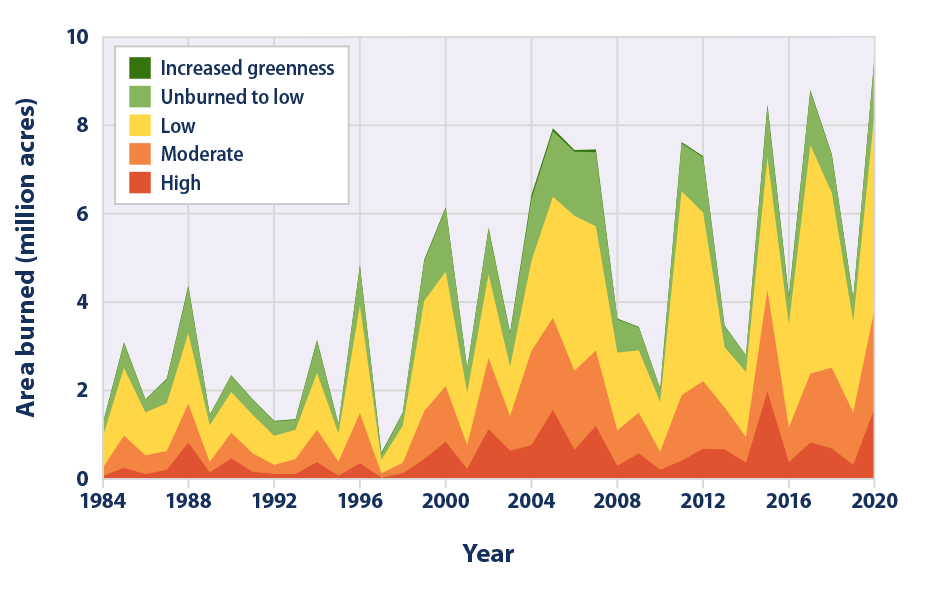Maui wildfires
Context
The lovely resort town was reduced to mounds of smouldering debris by the blaze, which broke out on Tuesday. It destroyed 1,000 buildings and rendered thousands of people homeless, making it the greatest natural disaster in the history of the U.S. state.
What are WildFires?
- Wildfires, which are frequently referred to as simply “wildfires” or “forest fires,” are uncontrolled fires that quickly spread through vegetation, such as forests, grasslands, or shrublands. These flames may start naturally, as in the case of lightning strikes, or they may be intentionally started by humans, as in the case of campfires, discarded cigarettes, equipment sparks, or purposeful acts.
- Wildfires can range in size and severity, from tiny, controlled flames that clear out underbrush and support healthy ecosystem processes to massive, devastating blazes that put people’s lives, property, and the environment in danger.

What are the causes of wildfires?
- Fuel: Fuel is the term used to describe the plants, such as trees, grasses, and shrubs, that give a fire fuel to burn. The kind, quantity, and dryness of the fuel all have an impact on how quickly a fire can start and spread.
- Weather: The weather has a big impact on how wildfires behave. Windy and dry weather makes flames more likely to start and spread more quickly. High winds and low humidity might make it more difficult to put out fires.
- Topography: How quickly a fire spreads can be impacted by the contour of the land. Slopes with a steep gradient can help fires spread more quickly, whilst valleys and canyons can concentrate and intensify the flames.
- Ignition sources: Fire sources include campfires, abandoned cigarettes, power lines, and human activity such as intentional acts or natural occurrences like lightning.
- Fire Behaviour: Wildfire behaviour can vary, including crown flames, which burn through the tops of trees, surface fires, which burn along the ground, and ground fires, which burn in the soil. Terrain, weather, and fuel distribution are a few examples of the variables that affect these behaviours.
What is happening in Maui?
- Wildfires Break Out: Early in August 2023, several wildfires broke out on the Hawaiian island of Maui. Dry and windy circumstances brought on by a potent high-pressure region to the north of Hawaii and Hurricane Dora to the south were the main causes of these flames.
- Spread and Effect: Driven by dry vegetation and high winds, the wildfires quickly spread across portions of Maui. As the quickly spreading fires endangered populated areas, evacuations were required, resulting in widespread anxiety and inconveniences.
- Damage and Deaths: The Maui wildfires severely damaged homes, infrastructure, and the island’s natural surroundings. At least 80 fatalities were tragically reported in the town of Lhain as of early August 2023 as a result of the fires.
- Emergency response: The state of Hawaii’s government acted in reaction to the developing scenario. On August 8, a declaration of emergency was signed, approving several actions. The Hawaii National Guard was activated, the director of the Hawaii Emergency Management Agency took action, and state money was used to support relief efforts.
- State of emergency: On August 9, the state of Hawaii declared a state of emergency for the whole state after realizing the gravity of the situation. With the help of this declaration, the state’s numerous counties and agencies might have more easily coordinated their operations.
How can we prevent wildfires from happening?
- Be Fire-Responsible: If you’re camping or using an outdoor fire pit, make sure the fire is out before you leave the area. Observe local campfire laws and refrain from starting a fire on windy days.
- Disposal: Properly Cigarettes should not be discarded in dry vegetation or from moving cars, and the same goes for matches. Make use of the right ashtrays and containers.
- Maintain Defensible Space: Keep Defensible Space Clear flammable grass, leaves, and other debris from the area around homes and other structures to maintain defensible space. This lessens the possibility of building flames spreading.
- Use Equipment Safely: Be careful when using equipment that produces heat or sparks, such as barbecues, chainsaws, and lawnmowers. Make sure that this equipment is kept up-to-date and used responsibly.
- Educate and Raise Awareness: Raising awareness and educating your community about the value of wildfire prevention. Engage in educational programs that instruct individuals on how to behave responsibly in fire-prone locations.
- Use Fire-Resistant Building Materials: When building or remodelling a home in a fire-prone location, take fire-resistant building techniques and materials into consideration.
- Remove dried Debris: Frequently remove combustible materials like dried leaves, dead plants, and other debris from your property’s roof, gutters, and surrounding areas.





